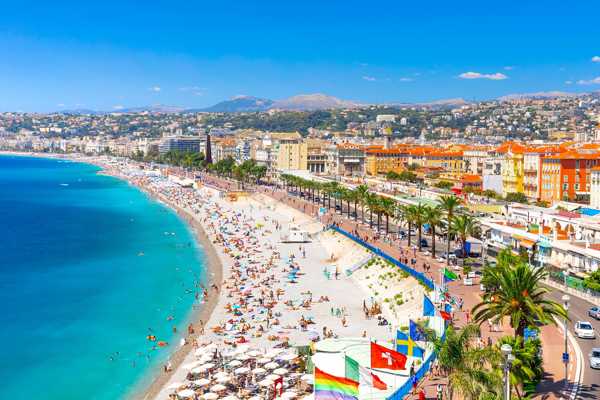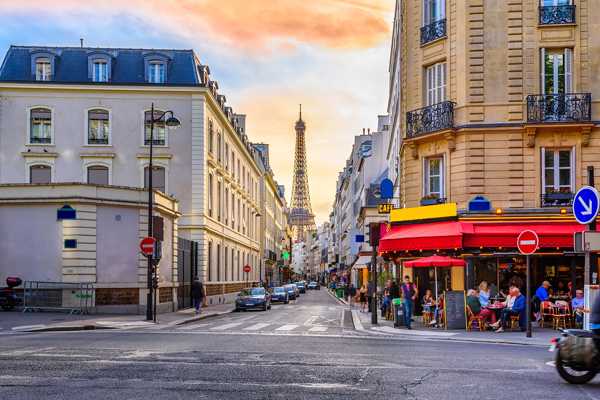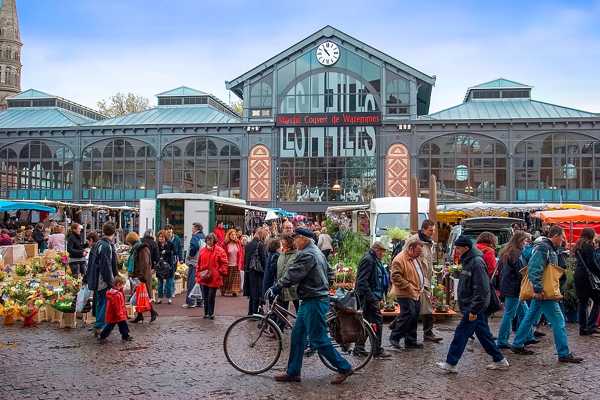Along with its dazzling culinary reputation, France has the best wine regions, famed for their world-class, award-winning wines. Every year, millions of tourists traverse the French countryside, visiting independent cellars that offer sublime tastings from local wineries and prestigious estates with rich viticultural pasts.
Our guide to the best wine regions in France will see you exploring undulating landscapes dotted with romantic chateaus, medieval cities, and charming chocolate-box villages in search of the perfect glass. Whether you’re a fan of a robust red, a crisp and fruity white, a sparkling rosé, or a floral Champagne, France’s wine regions have plenty to offer.
- 1
La Champagne
The birthplace of sparkling wine

- Cibo
- Storia
In north-eastern France, 145 km from Paris, the Champagne wine region is celebrated for its production of the world’s favourite effervescent, alcoholic beverage. The historic city of Reims boasts several UNESCO World Heritage Sites (including Basilica Saint Remi and the Cathedral of Notre-Dame de Reims), which is even more reason to visit.
Prestigious wineries pepper the region’s rolling green terrain (including renowned Champagne houses and boutique grape growers), so you’ll be spoiled for choice when it comes to tastings and tours. Visit Taittinger for a glass of high-end bubbly and a stroll through ancient Roman chalk cellars, or stop at the family-owned Voirin-Jumel estate for a glass of their famous Cuvee 555 Brut and a walk through the vineyard.
- 2
L'Alsace
A vinophile’s playground

- Cibo
- Storia
While not as well-known as some of its more esteemed, wine-producing counterparts, Alsace's unique geographical position near the German border is the reason why French and Germanic influences can be seen across its many vineyards. If you’re an aficionado of wines like dry Riesling, Pinot Blanc and Gewurztraminer, this is the place to take a road trip.
Visit prominent wineries like Domaine Weinbach and Jean-Baptiste Adam in the summer or stop by Alsace in December for magical Christmas markets in places like Strasbourg, Haguenau or Colmar. The UNESCO World Heritage Site of Petite France is a hotbed of half-timbered architecture and flower-filled window boxes – all which can be seen from a boat ride on the River Ill.
- 3
La vallée de la Loire
A UNESCO fairy tale

- Cibo
- Storia
The Loire Valley is arguably France’s most recognised wine region thanks to its undulating emerald vineyards, fairy tale chateaus and a vast array of UNESCO World Heritage Sites. You could spend an entire year here ambling along its beautiful backroads while stopping at wineries such as Chateau de Miniere, Maison Laudacuis and Domaine de Rocheville.
Vallée de la Loire boasts 22 historic castles found along the Loire River and its tributaries, including the 16th-century Château de Villandry (with extensive gardens and hedged labyrinth) and Château de Chenonceau (which appears to be floating on water when viewed from certain angles). Don’t miss the fine-dining restaurants on offer, including La Roche le Roy (try the scallop blanquette and barbecued blue lobster).
- 4
La Bourgogne
Tiny but tantalizing

- Cibo
- Storia
France’s Burgundy wine region might be small, but it’s considered a powerhouse in international viticultural circles thanks to its exceptional annual output. Home of Pinot Noir and Chardonnay grapes, some of the world’s most expensive bottles are produced here, but don’t worry – there are plenty of affordable wines to enjoy too.
Visit Domaine d'Ardhuy, a gorgeous family-estate winery that specialises in silky biodynamic wine or swing by Maison Jaffelin in the historic walled town of Beaune for handcrafted wines that are brought to life using a rare, vertical winepress. Don’t miss out on a trip to Dijon either – this remarkable city showcases spectacular medieval, Gothic, and Renaissance architecture including the Church of Our Lady and the Place de la Liberation.
- 5
Le Jura
A majestic mountain gem

- Cibo
- Storia
Bordering Switzerland, France’s mountainous Jura wine region produces a mammoth 11 million bottles annually, despite being compact in size. Some of the country’s most unusual wines are made in this cool-climate landscape including vin de paille (crafted from grapes dried on straw mats) and vin jaune (a yellow wine that’s akin to dry fino Sherry).
Drive along the Jura Wine Route to sample an eclectic collection of reds, rosés and refreshing sparkling wines in glorious foothill vineyards, surrounded by caves, waterfalls and historic villages like Arbois and Poligny. At Fruitière Vinicole d'Arbois, a cooperative wine cellar dating back to 1906, you can enjoy a fabulous afternoon tasting inside the magnificent Château Béthanie.
- 6
La Savoie
Underrated excellence

- Cibo
- Storia
Set in eastern France, Savoie was once known as the heartland of ‘ski chalet’ wines but today the conversation has changed. Entrepreneurial vintners have transformed this Auvergne-Rhône-Alpes region into a dynamic and imaginative winemaker’s paradise that’s celebrated for its compelling flavour profiles and epicurean prowess.
Savoie is the place to go for dry, fragrant and full-bodied whites, as well as characterful, spicy reds. Visit the Domaine de l'Idylle winery for breath-taking mountain views and a delectable Gourmet Immersion tour which will see you learn all about the Tiollier family’s winemaking process, before tasting 7 exquisite bottles and exploring the cellar.
- 7
Bordeaux
The wine capital of the world

- Cibo
- Storia
Set on the dramatic Atlantic coastline in southwest France, Bordeaux is a major player in the global wine industry thanks to its 65 appellations. Known for its Merlot, Malbec, Petit Verdot and Cabernet Sauvignon grape varieties, the region is the motherland of rich exquisite reds and boasts over 7,000 chateaus (also known as wine estates).
Hit the road on the Bordeaux Wine Trail (which encompasses 5 unique routes) to experience first-class wineries, charming UNESCO villages and some of the best restaurants in the country including Le Bouchon Bordelais and Chez Jean-Mi. There are plenty of other attractions too, like the Grosse Cloche de Bordeaux (an iconic 1775 gatehouse) and medieval Saint-Émilion which offers wonderful strolls along its winding cobbled streets.
- 8
La vallée du Rhône
A good time amongst the vines

- Cibo
- Storia
Rhône Valley, southeast France, may be the nation’s second-largest wine-producing region, but it also has outstanding feats of UNESCO architecture in cities such as Lyon, Orange and Avignon. Boasting a wide array of soil types, Rhône is known for producing outstandingly rich Syrah reds and full-bodied Roussanne whites which one can enjoy at innumerable winery tastings or at fine-dining restaurants.
Visit 18th-century Château Fortia for an enthralling tour before stopping at La Cave de Mathias, a rustic, underground wine bar and contemporary art gallery run by a talented local sommelier. Sweet lovers can’t miss a trip to Cité du Chocolat Valrhona, an epicurean extravaganza dedicated to all things cocoa. Try the Itakuja pralines infused with passionfruit.
- 9
Le Languedoc-Roussillon
Affordable luxury

- Cibo
- Storia
For those on a tighter budget, Languedoc-Roussillon offers an inexpensive holiday in a glorious stretch of wine country thanks to its multitude of camping opportunities and enviable Mediterranean climate. This beautiful region (the nation’s biggest wine producer) boasts French, Spanish and Catalan influences which can be found in the vino, art, food and architecture.
Visit the 17th-century Château de Flaugergues (an elegant mansion-style house featuring a carved staircase, Flemish tapestries, an eco-vineyard and cellar tastings), before exploring Abbaye de Fontfroide (a former Cistercian monastery with its very own winery). History buffs will relish a day out at the Amphitheatre of Nîmes, a stunning Roman relic built nearly 2,000 years ago, or Cité de Carcassonne, a UNESCO-listed medieval city.
- 10
La Provence
A feast for the senses

- Cibo
- Storia
Provence is a South of France hotspot, famed for its heritage wine production and its glamorous Mediterranean riviera, brilliant-hued lavender fields and medieval hilltop towns. From the city of Nice to the coastal region of Camargue, the region’s meandering wine route will see you sampling rosés, reds and whites in picture-postcard surroundings.
Château de Saint Martin in Taradeau is one of Provence’s oldest estates (their wine and cheese tastings are the stuff of legend), while Abbaye de Lérins (a Cistercian monastery on the island of Saint-Honorat) boasts a vineyard that is tended to by monks. If you’re looking for the perfect union of charm, shopping and gastronomy, visit the Provençal town of L'Isle-sur-la-Sorgue with its idyllic waterways, al fresco eateries and old-world antique shops.


















